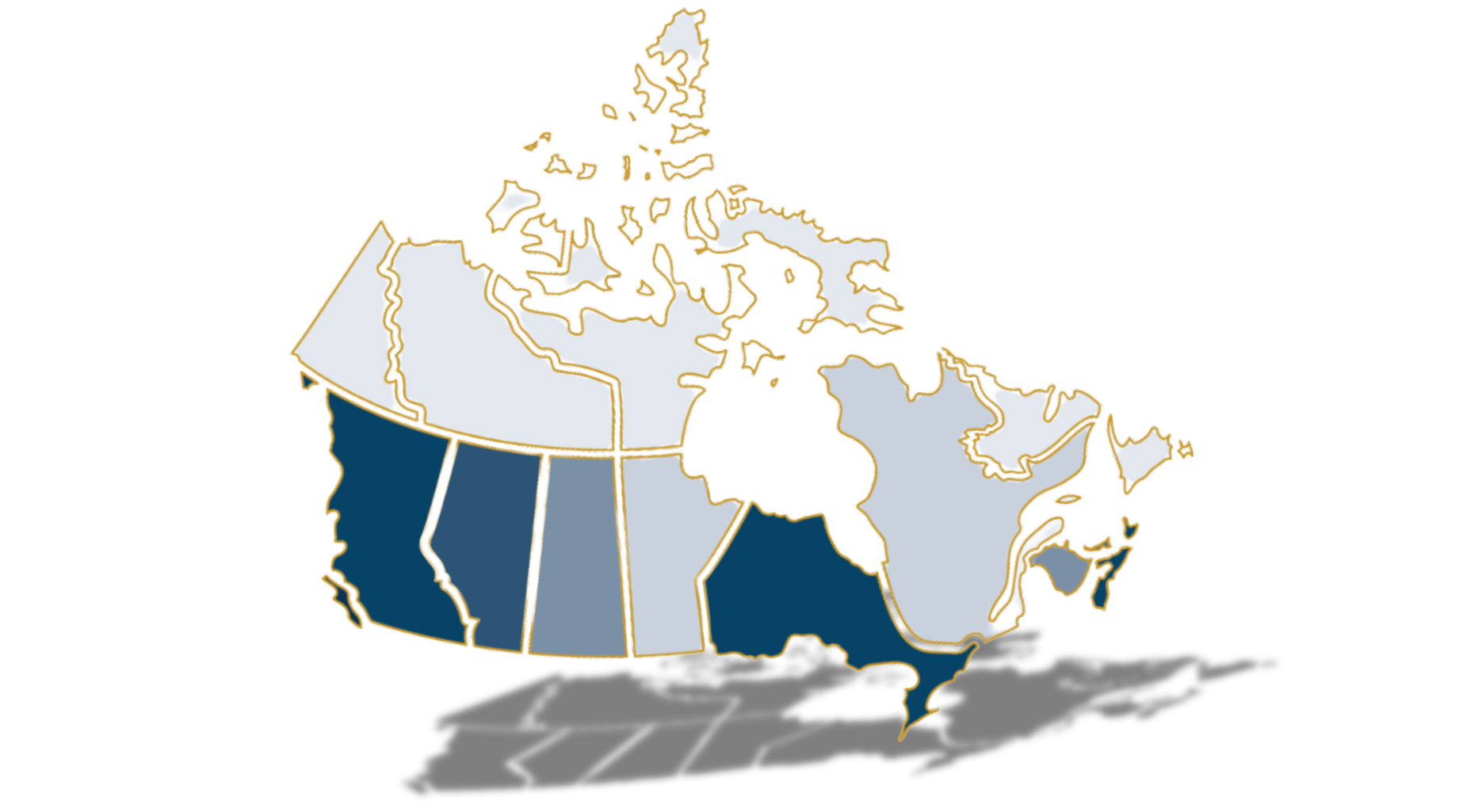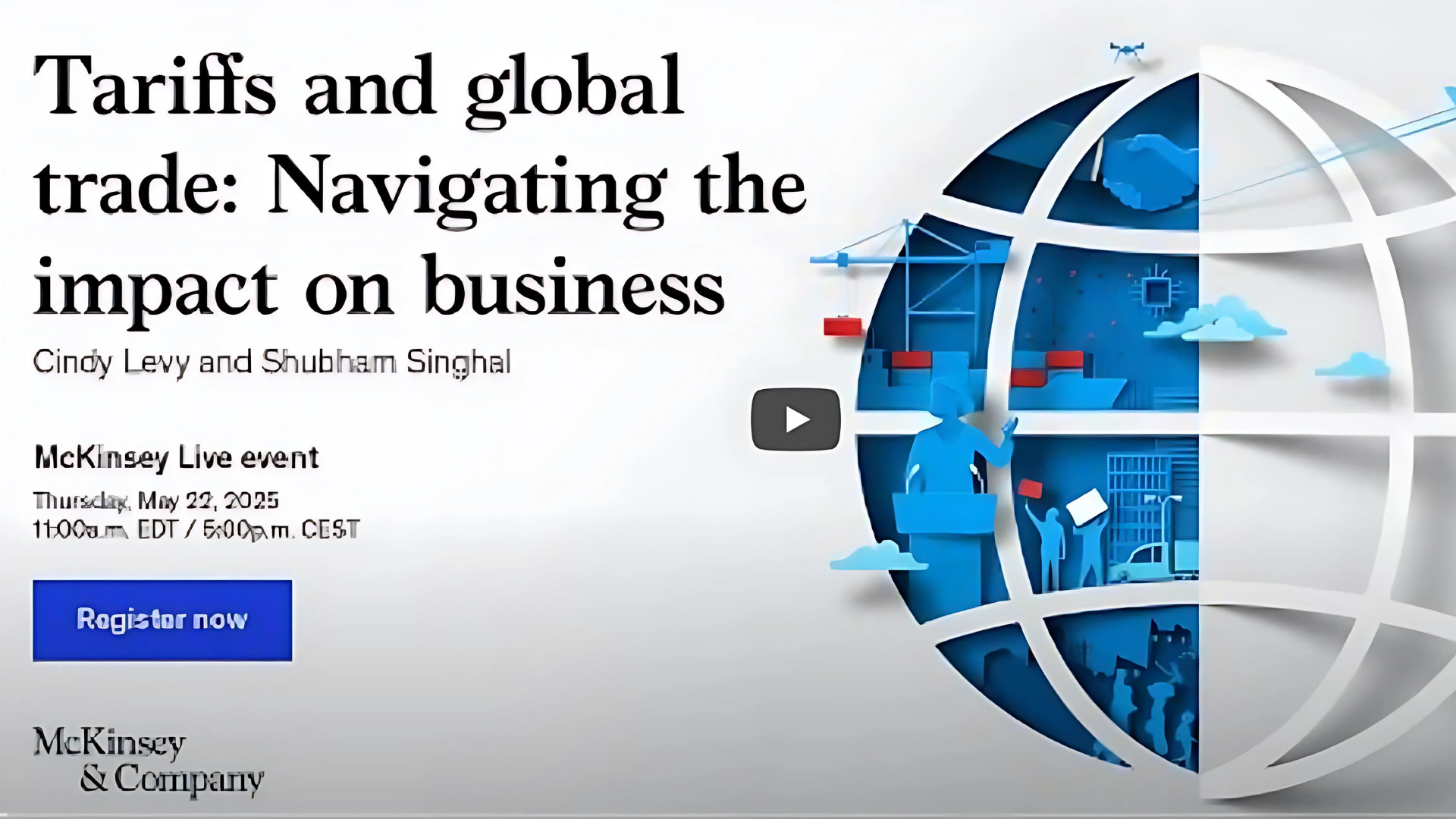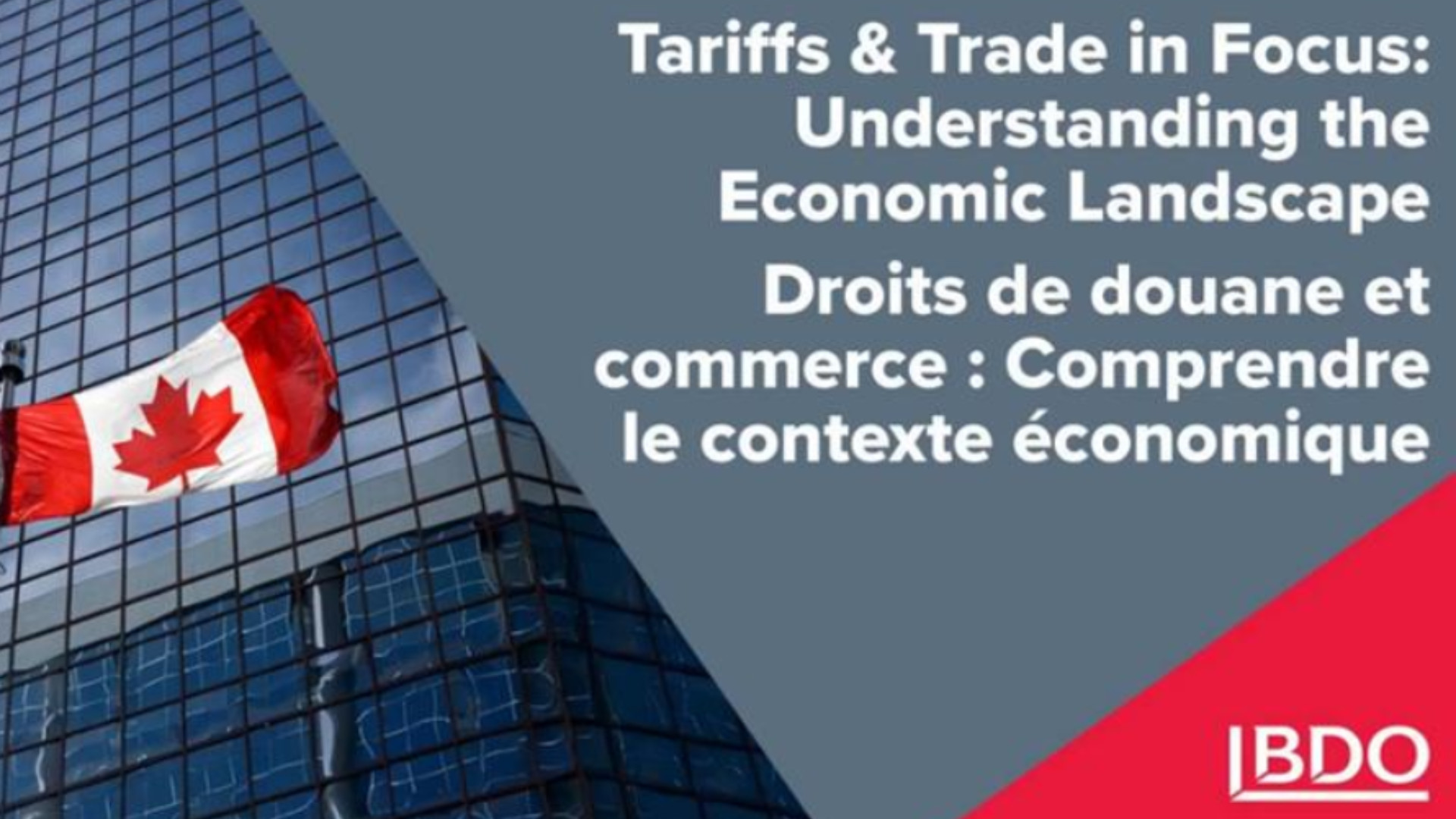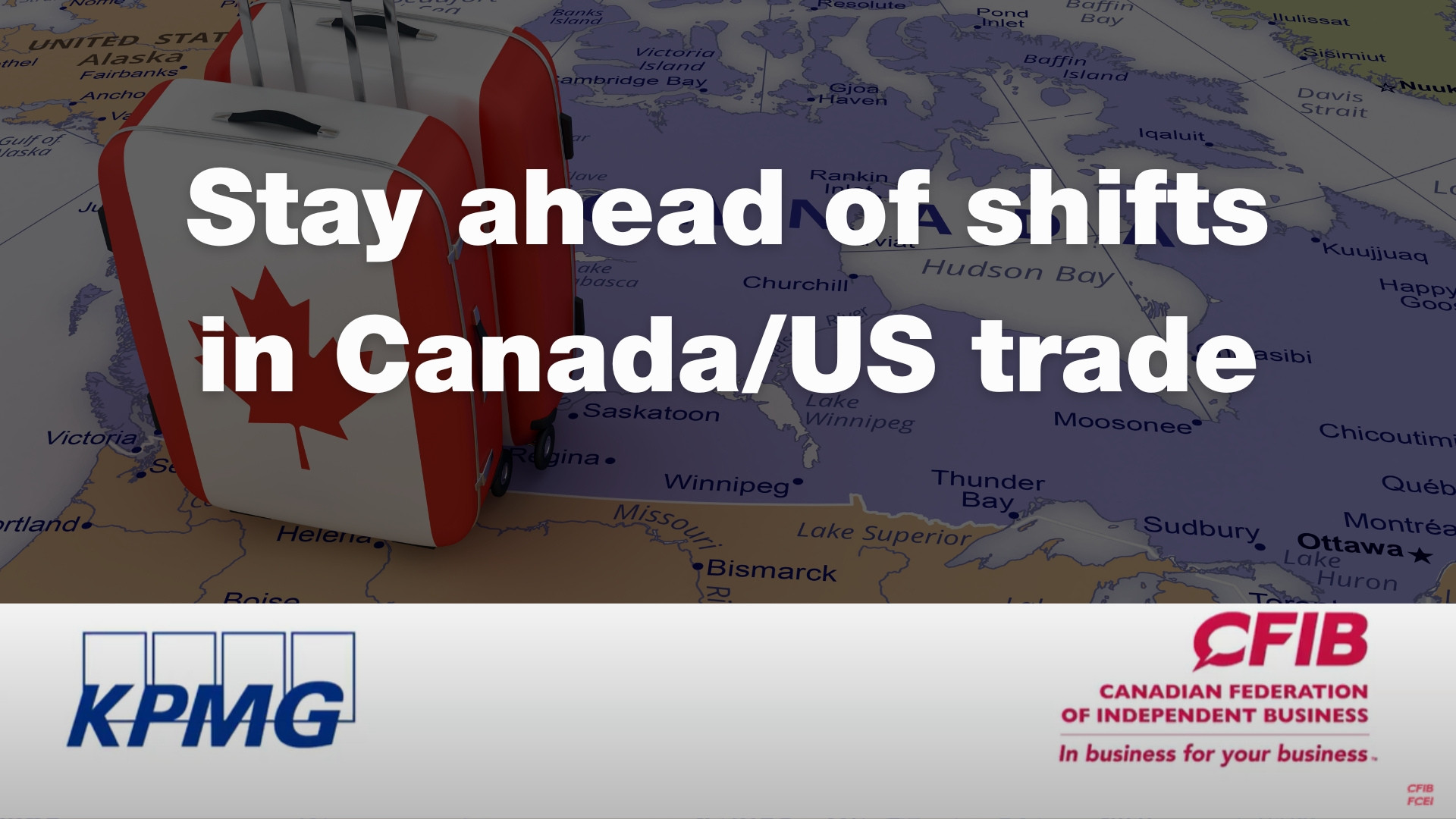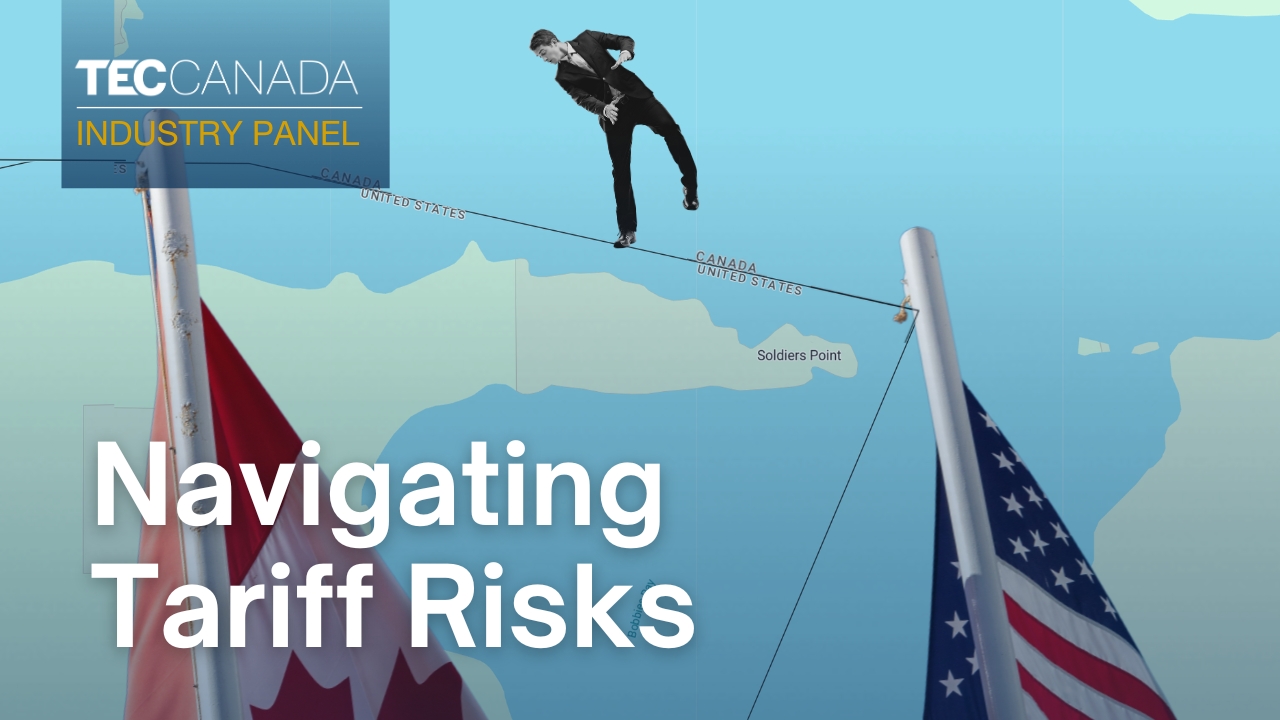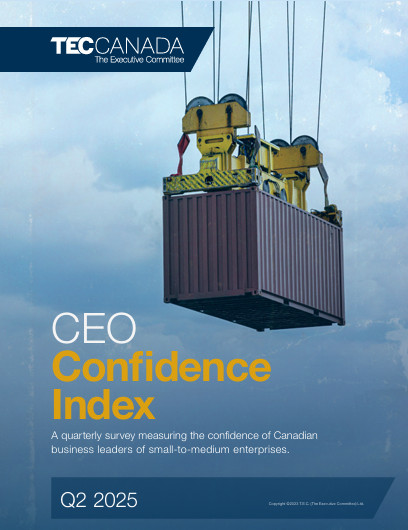June 3, 2025: President Donald J. Trump signed a Proclamation increasing tariffs on steel and aluminum from 25% to 50%, further complicating the global trade landscape. The increase in U.S. metals tariffs came into effect at 12:01 a.m. (0401 GMT) on June 4, 2025. It applies to all trading partners except Britain, the only country so far to strike a preliminary trade agreement with the U.S. during a 90-day pause on a wider array of Trump tariffs. The increase in the levies jolted the market for both metals this week, especially for aluminum, which has seen price premiums more than double this year.
Navigating the Proposed Tariffs: What Canadian Business Leaders Need to Know
Industry-leading insights and our latest resources to help Canadian business leaders navigate tariff changes with confidence.
TEC Canada is committed to providing CEOs and business leaders with real-time updates and expert perspectives to help them make informed decisions. This page will be continually updated with:
Latest News & Policy Updates | Tariffs and Trade Policy
Stay informed on evolving trade regulations and their implications.
Jun 3, 2025: President Trump raised Section 232 tariffs on steel and aluminum from 25% to 50% on June 3, 2025, citing national security concerns over import surges and global overcapacity. Read more here.
May 28, 2025: A U.S. trade court blocked President Trump’s sweeping tariffs, ruling he exceeded his authority under the emergency powers act, but a federal appeals court reinstated them the next day while reviewing the government’s appeal, with responses due June 5 and June 9. The back and forth ruling adds uncertainty to North American trade relations and ongoing negotiations. Click here to learn more.
May 3, 2025: The United States imposed 25% tariff on automotive parts became effective, with an exemption for parts that meet CUSMA requirements, which can be exported tariff-free. Details of this tariff can be found here.
April 15, 2025: Canada has introduced targeted support for businesses hit by U.S. tariffs, including tariff relief for certain imports and a loan facility for key large enterprises. These measures aim to ease supply chain disruptions and protect Canadian jobs and industries. Click here to learn more.
April 9, 2025: Trump announces 90-day pause on reciprocal tariffs for 75 non-retaliating countries, and raises levies on China to 125%
April 8, 2025: The U.S. will impose 104% tariffs on China starting at midnight on April 9, 2025, as Canada prepares to launch auto tariffs.
April 3, 2025: President Trump’s 25% tariff on all foreign-made automobiles takes effect and Canada responds with a reciprocal 25% tariff on all vehicles imported from the United States that are not compliant with CUSMA.
April 2, 2025: Trump Unveils Sweeping Levies in Stark Shift in Trade Policy
President Trump announced a sweeping new tariff policy—imposing a baseline 10% tariff on all U.S. imports, with steeper reciprocal tariffs for select countries such as 34% on Chinese goods and 20% on European Union imports—while notably making no mention of Canada or Mexico. The announcement triggered a sharp selloff in U.S. stock futures and raised fears of economic fallout, though some analysts believe the market overreacted and view the move as a negotiation tactic.
March 13, 2025: It’s Prime Minister Justin Trudeau’s last day in power, and his replacement, Mark Carney, said he’s ready to sit at the negotiating table with U.S. President Donald Trump so long as Canada’s sovereignty is respected. In the Oval Office, Trump said today Canada could keep its anthem if it became a state. Meanwhile, the trade war continues. Trump’s 25 percent tariffs on steel and aluminum are in effect, and so are Canada’s countermeasures on $30 billion worth of U.S. goods.
March 12, 2025: Trump metals tariffs draw swift retaliation from Canada and EU | Canada imposes C$29.8 bln in retaliatory tariffs
March 11, 2025: President Trump announced that new retaliatory tariffs on Canada, which were scheduled to take effect on Wednesday, would be raised to 50% instead of the previously planned 25%. He asserted that the only solution was for Canada to join the United States. However, he later reversed his decision after Ontario agreed not to impose tariffs on electricity exports.
March 7, 2025 (Reuters): Canada on Friday unveiled billions of dollars in aid and other forms of support to businesses and people expected to be directly affected by U.S. tariffs. These relief measures involve over C$6.5 billion ($4.52 billion) of financial aid to help companies tap new international markets, absorb the impact of losses, access easy loans and prevent layoffs, a team of ministers said.
March 6, 2025: The Trump administration will delay imposing 25% tariffs on Canada and Mexico for goods and services compliant with the USMCA trade agreement. The waiver will last until April 2, Commerce Secretary Howard Lutnick said Thursday, adding that he hopes the two nations will do “a good enough job” combating the flow of fentanyl. President Trump intends to introduce fresh tariffs next month, including reciprocal levies and industry-specific ones on cars, pharmaceuticals and semiconductors.
March 5, 2025: Trudeau outlines response to U.S. tariffs, says Canada will ‘relentlessly’ fight to protect the economy
Prime Minister Justin Trudeau, speaking from Parliament Hill on Tuesday, says Canada will immediately start imposing tariffs on $30 billion worth of U.S. goods. Trudeau said tariffs will be imposed on the remaining $125 billion of American products in 21 days as a response to U.S. tariffs that went into effect on Canada Tuesday.
March 4, 2025: Trump triggers trade war, price hikes with tariffs on Canada, China and Mexico
Overview
On March 4, U.S. President Donald Trump imposed new 25% tariffs on imports from Canada, Mexico, and China, escalating trade tensions and introducing new economic uncertainties. The tariffs, which Trump claims are aimed at addressing trade imbalances and the flow of fentanyl into the U.S., could disrupt $2.2 trillion in annual trade and lead to higher costs for businesses and consumers across North America.
Key Developments & Reactions
- Immediate Tariff Impact:
- The U.S. has introduced 25% tariffs on Canadian and Mexican goods and new duties on Chinese imports.
- Further tariffs are planned for April 2, including “reciprocal tariffs” aimed at countries with existing duties on U.S. goods.
- Key affected sectors include electronics, agriculture, consumer goods, and automotive.
- Canadian Government Response:
- Prime Minister Justin Trudeau called the tariffs “a very dumb thing to do” and responded with 25% tariffs on C$30 billion ($20.7B USD) worth of U.S. imports, including food, beverages, appliances, and motorcycles.
- Trudeau warned that Canada will escalate tariffs to C$125 billion if the U.S. does not reverse course within 21 days, likely affecting automobiles, steel, aircraft, beef, and pork.
- Ontario Premier Doug Ford retaliated by:
- Canceling a C$100 million contract with Elon Musk’s Starlink network.
- Banning U.S. firms from Ontario government contracts.
- Threatening a 25% surcharge on Ontario’s electricity exports to the U.S.
- Mexico’s Response:
- President Claudia Sheinbaum vowed retaliatory measures, with details expected on March 10.
- China’s Response:
- China immediately imposed 10-15% retaliatory tariffs on U.S. goods, particularly targeting agriculture and manufacturing.
- The Chinese government stated it is prepared for a “tariff war, a trade war, or any other type of war”.
Economic Implications
- Stock Market & Currency Reactions:
- The tariffs triggered a global stock sell-off.
- The Canadian dollar and Mexican peso initially dropped but recovered slightly after U.S. officials suggested a potential partial resolution.
- Higher Prices for Consumers:
- Target CEO Brian Cornell confirmed that U.S. retail prices on imported goods, including avocados, grocery products, and electronics, will increase within days.
- Best Buy CEO Corie Barry warned of higher costs for electronics, as China and Mexico are top sources for U.S. consumer technology.
- Economists estimate the tariffs could lead to an extra $1,000 in annual costs per U.S. household.
- Potential Economic Slowdown:
- The Federal Reserve Bank of Atlanta revised its U.S. GDP outlook from +2.3% growth to a -2.8% contraction in Q1 2025.
- Experts warn that a prolonged trade war could halt North America’s economic momentum, with severe consequences for manufacturing, exports, and cross-border business operations.
What’s Next?
- March 10: China’s new tariffs take effect.
- March 24: Canada may expand its tariff list if U.S. duties remain in place.
- April 2: The U.S. is set to introduce additional tariffs on more goods.
- Ongoing: Talks between the U.S., Canada, and Mexico could lead to modifications but are unlikely to eliminate the tariffs entirely.
Conclusion
The trade war between the U.S., Canada, and its key partners is escalating, with retaliatory tariffs, economic disruptions, and rising costs threatening business operations across North America. TEC Canada members should monitor developments closely, as the situation continues to evolve.
Feb 24, 2025: Canada & Mexico Intensify Border Talks to Avoid U.S. Tariffs
Canada and Mexico are ramping up efforts to prevent the implementation of punishing 25% tariffs on their exports to the U.S., set to take effect on March 4. These tariffs could severely impact the integrated North American economy, affecting key industries such as automotive, energy, and manufacturing.
Key Developments:
- Increased Border Security – Both countries have enhanced their enforcement efforts, with Mexico deploying 10,000 national guard troops to its northern border and Canada appointing a “fentanyl czar” to combat opioid smuggling.
- Ongoing Negotiations – Discussions this week, alongside reports from the U.S. Department of Homeland Security, will determine whether the Trump administration extends the tariff suspension.
- Retaliation in Play – Canadian Prime Minister Justin Trudeau has warned of retaliatory tariffs on $107 billion worth of U.S. imports, including American beer, bourbon, and Florida orange juice.
Even if a temporary extension is granted, trade experts suggest that tariff threats will likely remain in place until clear evidence shows that these new measures are effectively reducing fentanyl smuggling and illegal migration.
This situation could also accelerate discussions on renegotiating the U.S.-Mexico-Canada Agreement (USMCA) ahead of its scheduled 2026 review.
With so much at stake for Canadian businesses, TEC Canada will continue to monitor developments and provide insights on how leaders can navigate these potential disruptions.
This article summarizes reporting by David Lawder for Thomson Reuters, please read the original article here.
Tariffs and Trade Policy | Resources & Tools Worth Sharing
A curated collection of resources and tools we believe are valuable for Canadian businesses as they navigate short- and long-term strategies while adapting to the evolving Canada-US trade landscape.
An online data visualization and research platform offering insights into international trade, economic complexity, and country-level import and export trends, supporting detailed analysis of tariffs and global market dynamics.
Across Canada, businesses are feeling the impact of market uncertainty. Export Development Canada (EDC) understands the challenges that exporters—the primary contributors to our economy—are confronting. For more than 80 years, EDC has stood tall when Canadian companies needed them most. Now, EDC is moving quickly to provide meaningful support to Canadian exporters and investors as you adjust and adapt to these new market realities.
The EDC Trade Impact Program will facilitate an additional $5 billion over two years in support for eligible companies across a range of products to help you navigate economic challenges.
If you’re an eligible Canadian exporter, or a company that supplies exporters, here’s EDC can help:
- Export confidently: EDC trade credit insurance protects against losses in the event of non-payment from your foreign buyer.
- Manage currency fluctuations: EDC offers solutions that mitigate the risks associated with foreign exchange fluctuations by stabilizing your costs and protecting your profit margins from adverse currency movements.
- Access more working capital: EDC guarantees share a portion of your financial institution’s risk, allowing you to access more financing for managing cash flow challenges and growing your operations.
- Enable global expansion: EDC’s financing solutions enable you to increase your capacity for trade, expand your footprint in different markets, or acquire a foreign company.
With $5 billion in additional capacity already allocated, EDC is ready to meet heightened demand for its financing and insurance solutions.
As trade conditions are sure to remain fluid, EDC will continue to adjust their support to meet your changing needs. EDC’s priority is to provide meaningful and timely support to Canadian exporters, so you can focus on what you do best: Provide the goods and services the world wants.
The priority of Export Development Canada (EDC) is to provide meaningful and timely support to Canadian exporters, so you can focus on what you do best: Provide the goods and services the world wants.
This tool from the Business Data Lab (BDL) and the Canadian Chamber of Commerce, explores provincial ties to the $3.6 Billion in daily Canada-U.S. trade that supports jobs on both sides of the border.
Most Requested Resources
Services and information
Tariff information and Harmonized System codes
Resources to identify tariff information for goods with HS codes
Canadian customs tariff
Tariff classifications for goods you want to import into Canada, apply for refunds
Export and import controls
Permits, certificates, policy notices, control systems, printable forms and guides
Canadian sanctions
Current and former sanctions and related measures, Canadian legislation, permits and certificates, listed person
Responsible business conduct abroad
Canada’s approach to settling disputes, standards, anti-corruption and due diligence
Trade agreements, negotiations and consultations
International trade and investment agreements, negotiations, impact assessments and consultations
Tariff and duty information, sanctions, export and import controls and other rules that affect Canadian traders.
The Canada Tariff Finder is a free online tool designed to help Canadian entrepreneurs who plan to import or export products. It allows users to search for products by keyword or Harmonized System (HS) code. Developed in collaboration with BDC, EDC, and the Canadian Trade Commissioner Service of Global Affairs Canada, this tool provides valuable tariff information to support international trade decisions.
Webinars Worth Watching
With new tariffs reshaping Canada-US trade, these TEC Canada webinars offer timely analysis and actionable strategies for business leaders. Join experts as they discuss economic implications, government responses, and what it all means for your business.
Analysis & Economic Insights
Hear from leading economists, trade specialists, and TEC Canada members at the forefront of the evolving Canada-US trade relationship.
Spring 2025 Economic Overview: Recent Developments in Canada’s Economy
Statistics Canada by Guy Gellatly and Carter McCormack
Pre‑Trade‑Conflict Momentum
Canada’s economy performed solidly before trade tensions escalated:
-
Real GDP grew steadily in late 2024, driven equally by household spending, exports, and business investment.
-
Final domestic demand surged +1.4%—the fastest in three years.
-
Year-over-year GDP rose 2.3% in Jan 2025, supported by gains in construction, oil & gas, and retail
Long‑Term Challenges: Productivity & Investment
-
Despite recent gains, GDP per capita remained below pre-pandemic levels, and non-residential investment per person stayed nearly 9% under baseline
- Canada’s labour productivity growth remains less than half of the U.S. rate, eroding competitiveness and pressuring unit labour costs
Trade Tensions & Cross‑Border Integration
-
U.S. tariffs (25%) on steel, aluminum, and autos introduced March 2025 triggered reciprocal Canadian measures.
-
Bilateral trade with the U.S. remains crucial: ~17% of Canada’s GDP and 2.6M jobs tied to exports; 15% of Canadian intermediate goods sourced from U.S. suppliers
- Cross‑border investment flows are massive: Canada held a net positive position of US $1.8 trillion with the U.S., making up 90% of its global net foreign assets
Economic Slowdown Amid Trade Uncertainty
-
Output contracted in February, and March showed just +0.1% GDP growth.
-
Business and consumer surveys from February reveal cautious actions—investment delays, hiring freezes, and lower sentiment due to tariff anxiety
- Imports from the U.S. climbed in early 2025 before receding in March. The trade surplus narrowed from ~$13.8B in January to $8.4B in March
What’s Next?
-
Statistics Canada will release Q2 2025 business survey data by late May, detailing exposure to U.S. trade and mitigation strategies.
-
Monthly updates on macro indicators and tariff impacts are available through the Canadian Economic Tracker
Takeaways for Policymakers & Businesses
-
Canada entered 2025 on a strong footing, but productivity stagnation and trade uncertainty threaten that momentum.
-
The nation’s deep economic linkages with the U.S. underscore the vulnerability to bilateral tensions.
-
Ongoing data releases will be essential for gauging the medium-term economic trajectory and informing timely policy decisions.
Critical Capital: How Canada can tap foreign investment for its mineral riches
RBC Thought Leadership Report
May 26, 2025
Canada’s Opportunity: A Global Race for Critical Minerals
As global economies race to secure supply chains for the green energy transition, Canada’s wealth of critical minerals positions it as a strategic player. Key allies—including the U.S.—are investing heavily in upstream resource projects. But unlocking Canada’s full potential requires massive capital, fast-tracked development, and proactive policy alignment.
Four Funding Sources to Accelerate Canadian Mining
To meet demand, Canadian mining companies can draw from a mix of investment channels:
-
Internal Cash Flow: Top-tier miners have amassed over $14B in capital reserves.
-
Equity Markets: Institutional investors may show renewed interest amid geopolitical urgency.
-
Foreign State-Linked Capital: Historically strong—especially from China—though now under stricter review.
-
Sovereign Wealth Funds (SWFs): Ideal partners due to long investment horizons and alignment with strategic goals.
New National Security Measures Shift Investment Landscape
Canada has introduced more stringent rules around foreign investment in critical minerals:
-
-
Investment Canada Act reforms allow review of minority stakes and indirect control.
-
Provincial protections, such as Ontario’s move to block non-domestic mineral claims, add further scrutiny.
-
These policies are aimed at reducing overdependence on foreign state-owned investors and improving transparency.
-
Managing China’s Existing Stake in Canadian Mining
Although new investment from Chinese SOEs is restricted, legacy holdings remain substantial. While not forced, potential diplomatic and trade retaliation complicates divestiture. Policymakers must weigh national security with market stability.
Canada’s $107B Mining Pipeline Needs Capital Now
With over 100 large-scale mining projects in development across the country, Canada has a once-in-a-generation opportunity to become a global leader in critical mineral production. But success hinges on attracting trusted, long-term capital while protecting national interests.
Implications for Canadian Leaders and Investors
Canada must strike a balance—welcoming strategic investment while safeguarding sovereignty and economic security. Building robust frameworks for transparency, governance, and selective foreign partnerships will be key to ensuring Canada can deliver on its mineral promise and lead in the global energy transition.
Spring 2025 Currency Market Overview – Focus on Canada
Based on RBC Global Asset Management’s latest currency outlook, read the full article here: https://www.rbcgam.com/en/ca/article/Currency-Markets-Spring-2025/detail
Canadian Dollar: Pressured but Undervalued
The Canadian dollar (CAD) has fallen to a record low against the U.S. dollar, a decline driven more by global currency movements than domestic weakness. RBC GAM emphasizes that the CAD’s underperformance reflects the outsized strength of the U.S. dollar and broader investor caution, rather than any fundamental deterioration in Canada’s economy. As the global macro environment stabilizes and the U.S. dollar begins to ease, the Canadian dollar is well-positioned to recover—particularly if commodity prices improve or risk sentiment turns more favorable.
U.S. Dollar: At a Peak?
The U.S. dollar remains significantly overvalued, reaching its highest level in nearly 40 years against major trading partners. A nearly 9% surge in the final quarter of 2024 was fueled by renewed investor confidence in U.S. economic policy following President Trump’s election victory, especially around trade and deregulation. However, RBC GAM believes much of the enthusiasm has already been priced in. With the U.S. dollar’s momentum now stalling, the longer-term outlook points to a gradual depreciation, which could create tailwinds for other currencies, including the Canadian dollar.
Global Currency Landscape
Beyond North America, several global currencies may benefit from a weaker U.S. dollar. The euro could gain traction as the Eurozone shows signs of stronger growth. Similarly, the Chinese yuan may stabilize or strengthen if China’s economic conditions improve. Overall, many G10 currencies appear undervalued relative to the U.S. dollar, and a broader rebalancing may unfold over time.
Implications for Canadian Investors
While the weak Canadian dollar presents near-term challenges—especially for U.S. travel or foreign purchases—it may also offer opportunities. Canadian investors holding U.S. or international assets have likely benefited from currency gains but should be mindful of potential reversals if the loonie rebounds. RBC GAM suggests that diversification remains key, and investors should monitor global conditions, commodity markets, and central bank policy signals when assessing currency exposure.
Tariffs have become a significant concern for businesses across industries. While some companies may assume these trade policies are temporary, history suggests otherwise. Tariffs often lead to structural shifts that businesses must adapt to in order to protect profitability and sustain long-term success.
To provide clarity and actionable insights, Colten Esser, Manager of Strategy & Research at TEC Canada, sat down with Avy Punwasee and Michael Stanisz, Partners at Revenue Management Labs. In this discussion, they explore the lasting impact of tariffs, effective pricing strategies, and key considerations for business leaders navigating these financial challenges.
Are Tariffs Here to Stay?
Colten Esser: Let’s start with the big question: Are tariffs here to stay? What are the chances we’ll see increases or, hopefully, decreases?
Avy Punwasee: Historically, once tariffs are enacted, they tend to be quite sticky. Removing them requires navigating complex bureaucratic processes, which means companies need to prepare for the long haul. Burying your head in the sand and assuming tariffs will be repealed in six months is not a sound business strategy.
Michael Stanisz: I completely agree. If you look at steel tariffs implemented in 2018, they’re still in place today. Even when tariffs are lifted, they often create long-term market shifts that are difficult to reverse. We’ve worked with businesses that faced tariffs for only a short period, but they are still feeling the effects years later.
First Steps: How to Manage Tariff Impacts
Colten Esser: What are the first steps businesses should take when dealing with tariff-related pricing challenges?
Avy Punwasee: There are three critical areas to assess:
- Financial Impact: Businesses must analyze their cost structure and determine the exact financial impact of tariffs.
- Competitive Landscape: Companies need to evaluate how competitors are responding to tariffs. Are they absorbing costs, passing them on, or finding alternative solutions?
- Customer Behavior: Some customers have fixed budgets and can’t immediately adjust to price changes. Businesses must anticipate shifts in purchasing behavior and adjust pricing or discount strategies accordingly.
Michael Stanisz: A key mistake we see is businesses solely focusing on cost analysis without considering market dynamics. If competitors shift their pricing, that affects your ability to pass costs along. It’s essential to take a 360-degree approach before making pricing decisions.
Communicating Price Increases Transparently
Colten Esser: Many businesses hesitate to increase prices, fearing customer backlash. How should they handle these conversations?
Michael Stanisz: Transparency is key. If you’re upfront about why prices are increasing—especially when tied to tariffs—customers are more likely to accept them. This is one of the easiest times to push pricing adjustments because customers understand tariffs are external forces beyond your control.
Avy Punwasee: A big mistake is trying to absorb costs entirely. If you’re silently eating a 20% cost increase, customers might later wonder why you were able to afford it in the first place. That opens the door to difficult negotiations down the road.
Strategic Pricing Adjustments: Beyond Just Raising Prices
Colten Esser: Aside from raising prices, are there other pricing strategies companies should consider?
Avy Punwasee: Absolutely. Businesses can explore:
- Bundling products to create perceived value.
- Restructuring discount strategies to maintain margins.
- Adjusting payment terms to offer flexibility while safeguarding revenue.
- Re-evaluating contracts to ensure long-term profitability.
Michael Stanisz: Another key strategy is understanding price sensitivity across different product segments. Businesses often spread price increases evenly across all products, but some are more price-sensitive than others. By strategically adjusting prices based on customer behavior and competitive dynamics, companies can optimize profitability without alienating customers.
The Role of Discounts and Promotions in a Tariff Environment
Colten Esser: How should businesses rethink discounts and promotions in light of tariff-related cost increases?
Michael Stanisz: One of the biggest mistakes businesses make is indiscriminately applying discounts. Any discount should be conditional—whether that means bundling additional purchases, committing to longer contracts, or participating in data-sharing programs. If you’re giving something away, you need to get something in return.
Avy Punwasee: In B2B industries, the challenge is even greater because pricing structures are often opaque, and contracts vary significantly. However, this is also an opportunity to clean up outdated discount structures that may no longer serve the business.
Should Companies Add a “Tariff Fee” on Invoices?
Colten Esser: Some companies are adding a “tariff fee” as a line item on invoices to improve cost transparency. Do you recommend this approach?
Avy Punwasee: While it may seem like a logical way to communicate the cost burden, it’s not ideal. Tariffs tend to become a permanent part of the cost structure, so instead of treating them as an add-on, it’s better to incorporate them into your base pricing.
Michael Stanisz: Adding a tariff surcharge now could become a long-term problem when tariffs remain in place for years. It’s better to adjust pricing holistically to avoid having a visible fee that customers may later challenge.
What About Businesses Not Directly Affected by Tariffs?
Colten Esser: Some companies assume tariffs won’t impact them because they don’t import goods. What’s your take on that?
Avy Punwasee: Even if you’re not directly affected, your customers might be. That means they will adjust their budgets, reallocate spending, and potentially reduce their demand for your products or services. Businesses that ignore these ripple effects risk being caught off guard.
Michael Stanisz: A great example is the software industry. While software companies don’t deal with tariffs directly, many of their clients are in manufacturing and logistics—industries deeply impacted by tariffs. If customers face higher costs, they may cut software budgets, renegotiate contracts, or delay purchases. No business operates in isolation, so it’s crucial to anticipate these downstream effects.
Final Thoughts: Preparing for the Future
Colten Esser: What’s your biggest piece of advice for businesses navigating pricing in a tariff-driven environment?
Michael Stanisz: Don’t be reactive—be proactive. Businesses that monitor competitor responses, analyze customer behavior, and adjust pricing strategies thoughtfully will be in a much stronger position than those that simply hope for the best.
Avy Punwasee: The key takeaway is that tariffs create lasting shifts in the market. Companies that embrace a strategic, data-driven pricing approach will not only survive but thrive in the long run.
Conclusion
Pricing strategies are more critical than ever in an uncertain trade environment. By understanding the financial, competitive, and customer implications of tariffs, businesses can develop smart, sustainable pricing models that protect profitability. The insights shared by Avy Punwasee and Michael Stanisz highlight the importance of proactive planning, transparency, and strategic execution.
For TEC Canada members and business leaders alike, now is the time to evaluate your pricing strategy and ensure you’re prepared for the evolving global trade landscape.
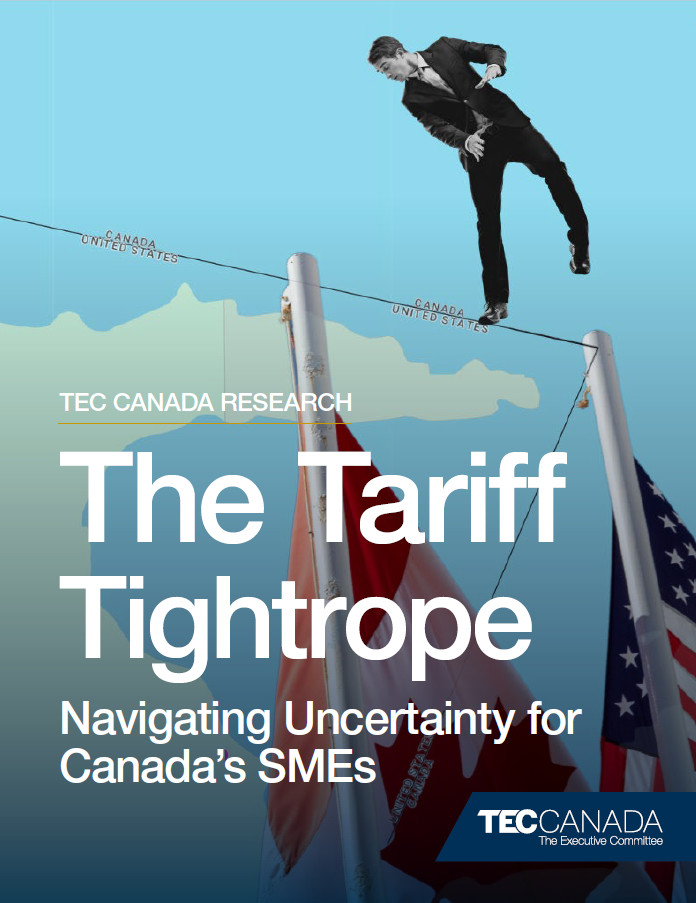
Click to Download
While President Trump’s tariff announcement may seem abrupt, it stems from deeper underlying forces shaping Canadian-American trade relations. Explore the motivations behind the proposed tariffs and discover strategies for SMEs to mitigate risk.
The TEC Canada CEO Confidence Index provides a real-time pulse on the Canadian economy, delivering valuable insights into evolving business conditions and the confidence levels of SME leaders.
TEC Canada’s CEO Confidence Index is a real-time pulse of the Canadian economy, offering a view into shifting business conditions and the confidence of Canada’s small and mid-size business community. Conducted between March 1st and 31st, 2025, the survey captured responses primarily from SMEs (fewer than 100 employees), with moderate representation from larger firms (up to 500 employees). The robust response rate in the survey ensures a high level of statistical reliability, making TEC Canada’s CEO Confidence Index one of Canada’s largest and most representative studies on economic confidence.
